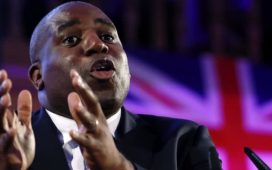Three pro-EU British political parties hope to to unveil a Remain election pact as early as Thursday, under which they will step aside for each other in dozens of constituencies to maximise Remain candidates’ chances.
But those involved in the talks warned that the plan, involving the Liberal Democrats, Plaid Cymru and Green party along with some independent MPs, entailed complex internal debates as well as intraparty discussions. “It’s not a done deal,” said one official.
The template for the cross-party deal was the recent Brecon and Radnorshire by-election, when the Lib Dems seized the seat from the Tories by just 1,400 votes after Plaid and the Greens did not run candidates.
The Lib Dems have already made clear they will stand aside in some seats such as Beaconsfield, where Dominic Grieve, a former Tory minister who had the party whip removed, is battling to save his seat. They could also step down in Broxtowe to give a fillip to Anna Soubry, the pro-Remain former Tory MP who now leads the Independent Group for Change.
Nick Stuart, the Lib Dem candidate on the Isle of Wight, is standing down to give a boost to the Greens, while the Lib Dems will also stand aside in Brighton Pavilion, held by Caroline Lucas, the Green party’s only MP.
In return Jo Swinson’s party will expect its rival pro-Remain parties to give it a clear run in seats where it did well in 2017.
The pact is expected to affect about 60 of the 632 seats in mainland Britain — although the precise number is fluid — to try to damage Boris Johnson’s hopes of a Tory majority.
There are limits to the potential impact of the agreement, judging by results in the 2017 general election. In the Isle of Wight, the Lib Dems won only 3.7 per cent of the vote, for example.
In Anglesey the Lib Dems are expected to stand aside to help Plaid, which came third with 27 per cent in 2017. But the Lib Dems only got just above 1 per cent at the last election in that seat.
In Powys the Lib Dems could benefit from Plaid stepping aside, but the Welsh nationalists picked up only 4.9 per cent in 2017. The seat was won by the Tories two years ago with 46 per cent, against 19 per cent for the Lib Dems.
One Plaid figure said the situation was much more dynamic than the statistics suggested. “It’s not a simple case of just adding the figure that the other party got in 2017 — things have changed. Having a single Remain candidate could galvanise quite a few Remain Labour and Green and Tory voters to come across,” he argued.
Heidi Allen, a Lib Dem MP, is trying to co-ordinate the talks through a group called “Unite to Remain”, which is backed by Julian Dunkerton, co-founder of the Superdry retail chain.
But efforts to persuade people to vote tactically have already caused rows, not least because of Labour’s ambivalent position on Brexit. A new tactical voting website from “Best for Britain” was criticised last week for urging pro-Remain voters to back the Lib Dems in some seats where the party came in way behind Labour at the last election.
For example, the site urged people to back the Lib Dems in Kensington in London, where incumbent Labour MP Emma Dent Coad has a majority of only 20.
Pro-EU figures inside Labour argue that the party’s backing for a second referendum is a more realistic proposition than the Lib Dems’ promise to revoke the Article 50 divorce process altogether.
Separately, in Northern Ireland, nationalist parties Sinn Féin and the Socialist Democratic and Labour party said they were each withdrawing from three seats to help boost the chances of anti-Brexit candidates.












